[ page 2 ]
1/72 scale model of the Super Etendard by Academy (or Italeri)
... back to page 1...
Another 1/72 scale kit was released by Academy in 1983 as kit #9. The kit #1602 was released in 1986 and is the same but with a new box.
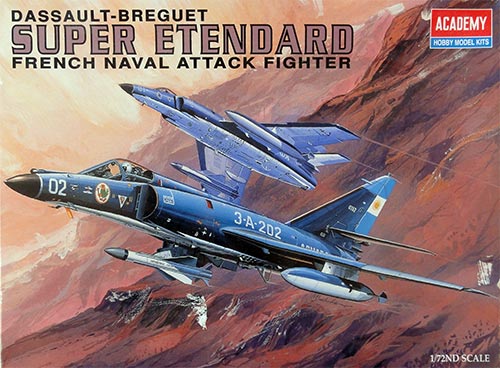
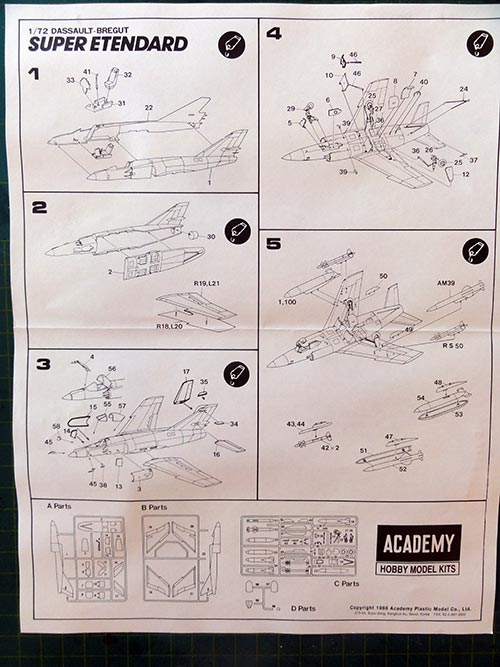

Decals are for a French Aeronavale aircraft of 11F and an Argentine Super Etendard with a choice of serial numbers.
It was also released by Italeri #152. The instructions are different but it has the same parts.

These kit releases were a few years after the Falkland War where the Super Etendard was used by Argentina and armed with the Exocet missile caused big losses to the British Fleet (see also page 1....)
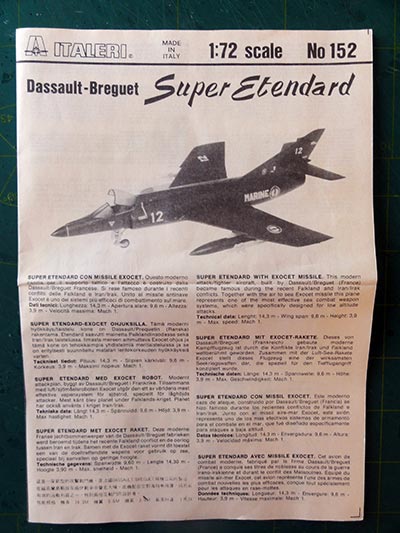
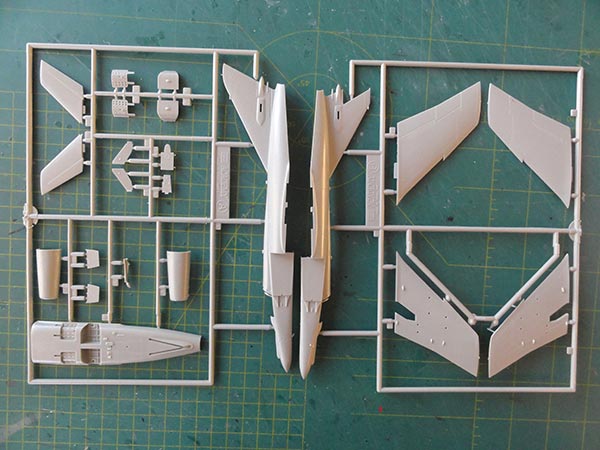
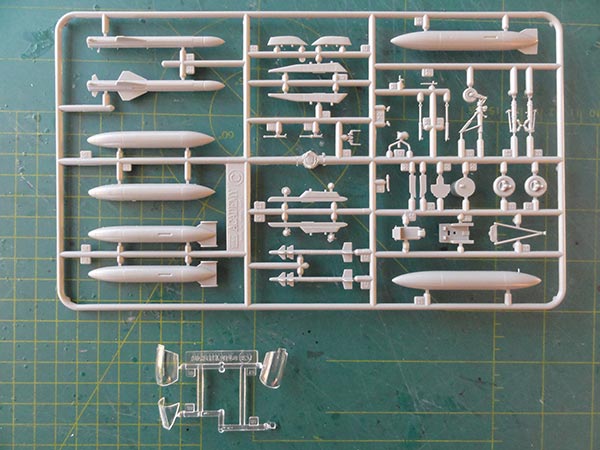
These kits have about 60 parts and the panel lines are finely engraved. The main gear doors can be posed open though open these are seen closed as well on parked aircraft. The kit has 2 canopies: 1 for closed and 1 for open position. The air brakes can be set open (but have closed holes).
Stores are 2 smaller fuel tanks, 1 larger fuel tank, 2 Magic missiles that are not too bad and an Exocet missile. The pylons look good but I noticed that the pylon for the Exocet is quite different as per kit. I looked at the old Heller kit and decided to make a new one based on that one.
I had both an Academy and a Italeri kit so 2 sets of parts. The decals were different but again for a French Aeronavale and Argentine aircraft. I did not see the Argentine scheme explained in the Italeri instructions, probably it was printed on the box bottom?
The decals are a mixed bag.
Italeri:
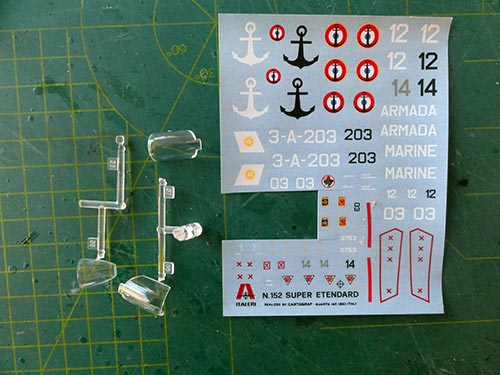
The Argentine naval aviation anchors are too "fat" and texts are bit too "thin".
Academy:
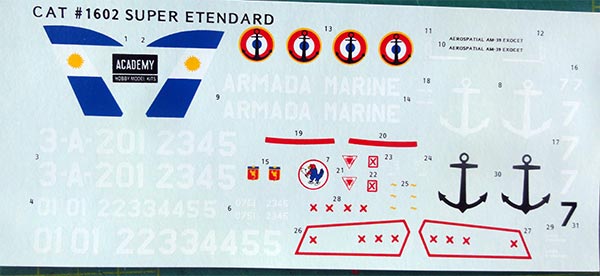
The Academy Argentine fin flash decals are far too dark blue whereas the ARMADA texts are better than those in the Italeri set.
The two kits were made in parallel:
1. Argentine "Aviacion Naval" ARMADA
2. Iraqi air force using decals from the spares decal box.
Assembly of the kits is very easy.
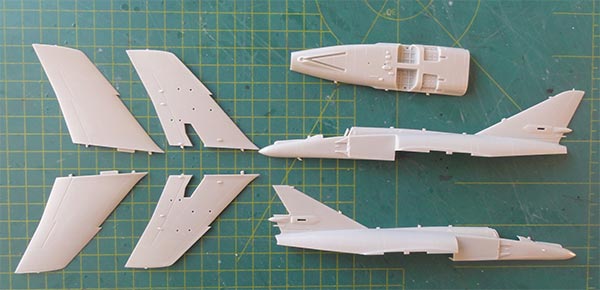
The cockpit is a bit simple and adding detail bits here may improve it. Such as side consoles, some throttles and harnesses and straps on the seat.
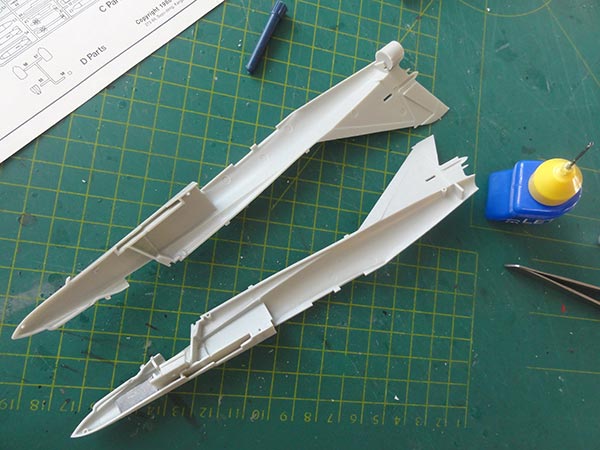
After assembly, a couple of light grey base coats were applied with the airbrush to check for any flaws that needed rework. The cockpit interior was very dark grey.
A bit filler / putty was needed in minor places such as the leading edge joint and the remainder could be handled with fine sanding.
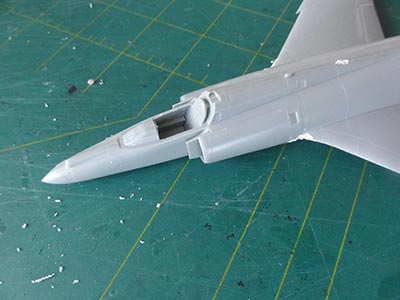
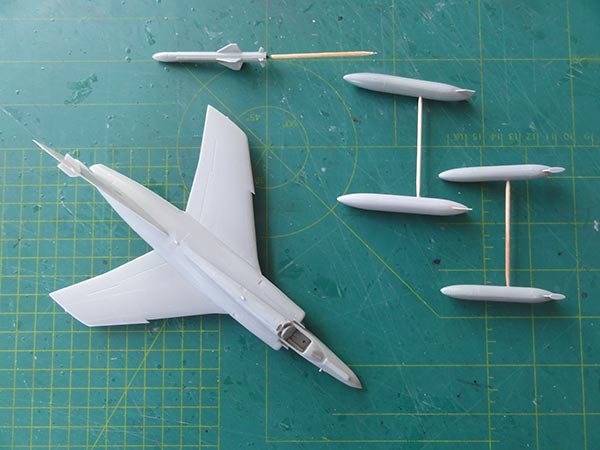
The Super Etendard had the standard paint scheme in most air forces.
The lower colour is white, using in
this case Gunze Sangyo H1 acrylic paint. This was applied first with the airbrush
and than masked.
When airbrushing fuel tanks I often drill a small hole at the locator point, a tooth pick can than be used as a hold.
For the upper Super Etendard
blue-grey colour I decided to use
Gunze Sangyo H56 intermediate blue acrylic.
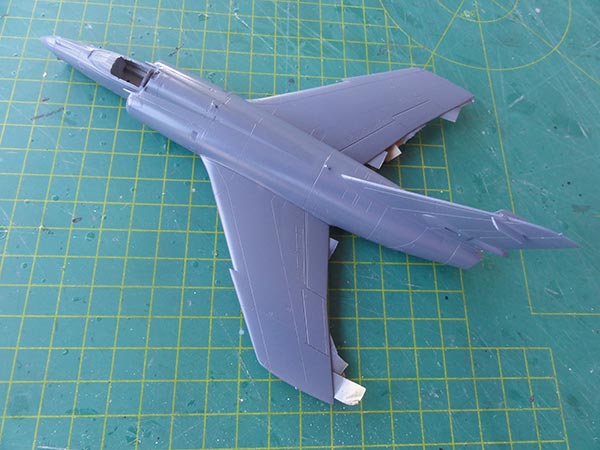
Masking with fine tape was needed as also the darker colour appears at the lower leading edges of the wing and runs under the wing root. It is extra work but can be done easily. Note also the grey at the wing - fuselage joint.
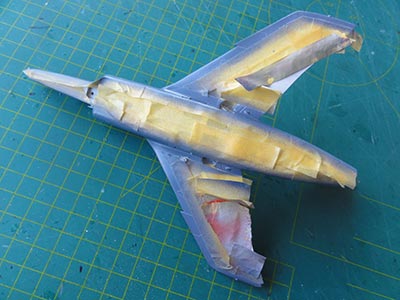
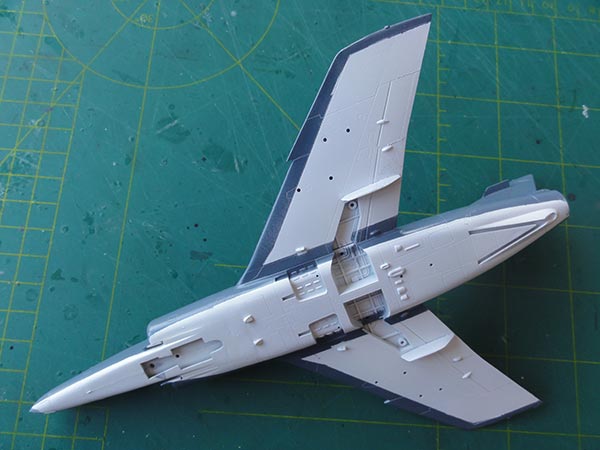
For the Argentine scheme portions of tail planes and fin were airbrushed white as well. I often also airbrushed a piece of spare decal just in case "repairs" would be needed later on to the paint scheme.
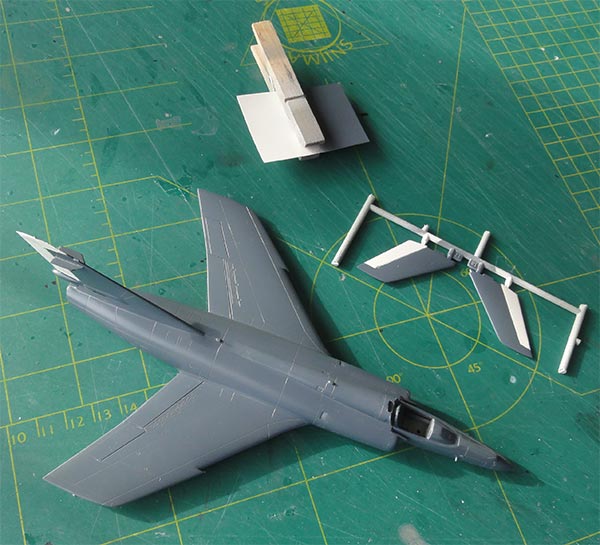
I used the kit decals and spare decals. To avoid "silvering" the models got some coats applied with the airbrush of Johnson Future/Pledge varnish.
The Academy kit decals are very thin so take care here. The Italeri decals are very notorious for their bad fixation glue so these "dragged" through some Future/ Pledge before setting them onto a model.
The Academy Argentine scheme fin flash decal #2 is too dark blue. I only used the "sun" in the flash, that was cut and and airbrushed the areas white and after masking the lighter blue in a mix of Revell Aqua 50% no.301 white + 50% no.50 blue. Note that the tailplanes white-blue panels are not indicated in the Academy instructions but well seen on real photos of Argentine Super Etendards.

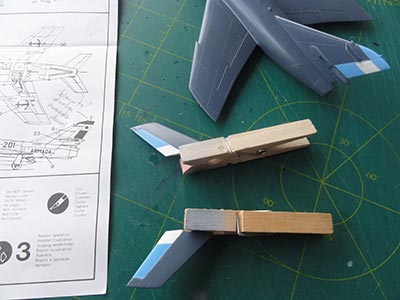
You get a selection of aircraft codes to choose from. I opted for aircraft "02" but the nose code decals #5 are a bit too large, I used them nevertheless finding no others in the spares decal box.
The unit marking on the nose is too large in diameter; I used the smaller one from the Italeri decal set but painted the small green portion now dark blue with a fine brush. ( Note that in the Italeri decals the "anchors" are too fat but the Academy kit decals are fine here).
The smaller stencils #25 should not be yellow but red. I suggested these with red paint using a tooth pick. On the intakes no red stripes are seen, only smaller white stencils and stripes as provided in the Academy kit, decals #11, 12.
What's also missing are the black aircraft codes on the lower wing tips, these were retrieved from my spares box.
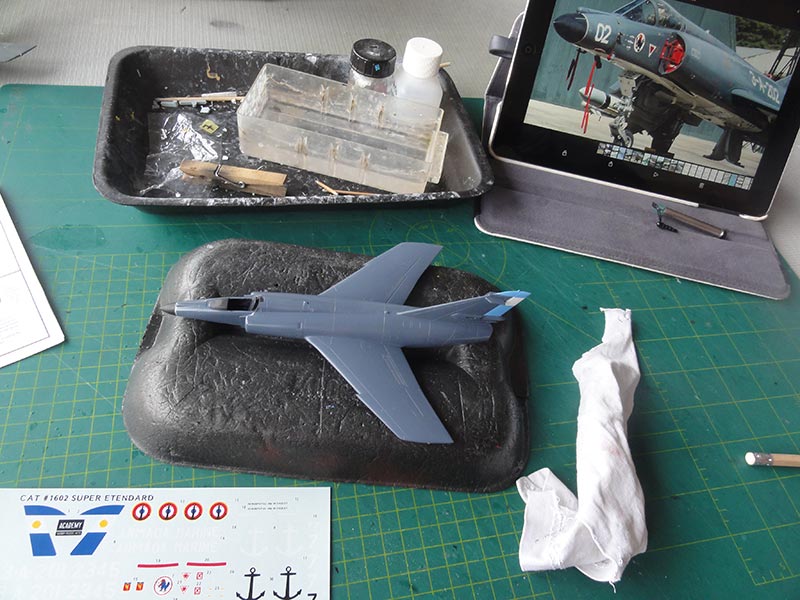

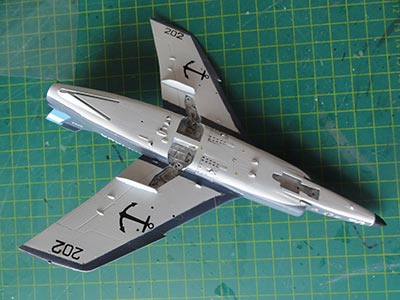
After decalling, details like the undercarriage were set on the model. The gear legs I painted aluminium with also alu wheel hubs. I added from thin metal wire some hydraulic lines on these.
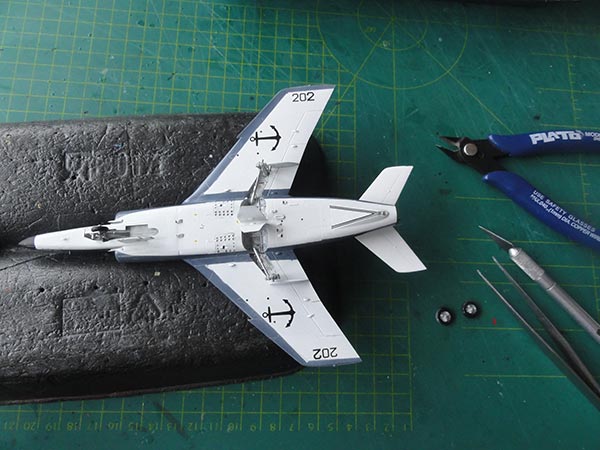
Installed were a single large fuel tank and the single Exocet missile. The Exocet parts in the kit are fine. The missile was painted white with a medium blue head. Smaller details and stripes were added from decals.
The kit Exocet pylon #47 was not used, it seemed incorrect in shape; I made a new one using the Heller kit pylon as example.

Though the kit Magic missiles are not bad, I used better ones retrieved from a Special Hobby Mirage F-1 kit, here painted in a white colour.
Anti-collision lights and tiny bits like the pitot tubes were painted. Overall a gloss transparant coat was airbrushed onto the model (using Johnson Future/Pledge varnish).
Inside the cockpit I added a few instrument decals found in the spares decals box. On the kit seat some harness details made from painted tape were set in place looking at a photo of the Safarn (Martin Baker) Mk.6 seat. Also the ejection pull chords were added. The seat was installed.
The canopy was set open after a mirror was installed at its inside frame and that completed the model.
ARGENTINA
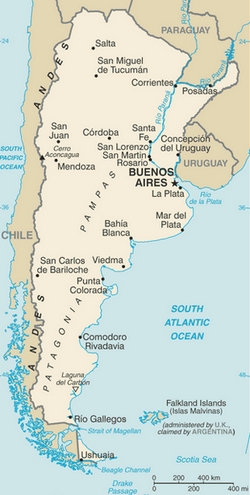

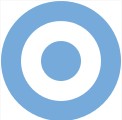


See for some historical notes on the Argentina naval air service ("Commando de Aviacion Naval") the Panther page here...
France also supplied in 1981 and 1982 14 Dassault Super Etendards to the naval air service that could fire the Exocet anti-ship missile. The conflict of the Falklands War emerged after Argentina declared that the "Islas Malvinas" e.g British Falkland Islands and South Georgia were now Argentinian "territory" and were occupied. Some military troops and Pucara's and smaller aircraft were deployed to small air strips. A furious British armed response followed and a large Royal Navy fleet was sent to the Falklands. The Royal Air Force carried out operation "Black Buck" with a mission to bomb particularly the runway at Stanley to avoid Argentinians to use the runway. A record distance of 15000 kilometers with Avro Vulcans requiring multiple in-flight refuelings.
The main Argentinian combat aircraft could operate only from the mainland such as Skyhawks and Mirages but the most notorious was the Super Etendard. Deployed on attack missions to the British fleet, the Super Etendards were refuelled in the air by KC-130H. The Argentinians had only received 5 Exocet missiles when the Super Etendards were purchased from France. Nevertheless large losses were inflicted on ships of the British Royal Navy. The Falklands were liberated after 10 weeks and British again.
Decades later still many Super Etendards were in service but it is unclear if the type is currently in use and serviceable.
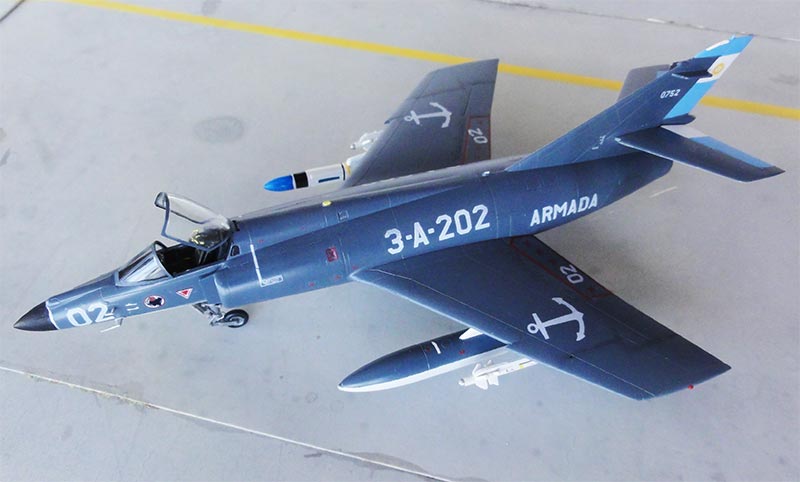
This particular aircraft 0752/ 3-A-202 flown by Capitain Bedacarratz started the first attack mission with another Super Etendard 3-A-203 flown by Mayora on May 4, 1982. That after an Argentine SP-2H Neptune had made radar contact south of the Falklands that was thought to be a large British warship. Taking off from Rio Grande base at 1245zulu armed with an Exocet each in-flight refuelling was done with Grupo 1 KC-130H and than at low level to avoid radar detection the attack run. Some other ships had been detected meanwhile, the biggest ship was picked but once nearby, the target was not found. A pop-up manoeuvre was done to allow the Super Etendard nose radar to pick up. This alerted the British radars and at 1350zulu no 801 squadron Sea Harriers were scrambled frtom HMS Invincible. The pair of Super Etendards after 25 miles had a succesful acquisition and at 1404zulu both fired their Exocet. The target was the HMS Sheffield warship. One Exocet hit the ship, the other missile result is unknown. The hit was catastrophic. The 2 attack jets returned back to Rio Grande at 1510zulu.
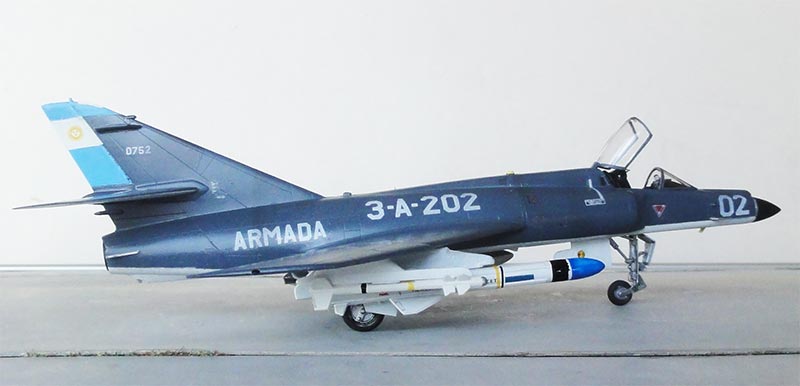

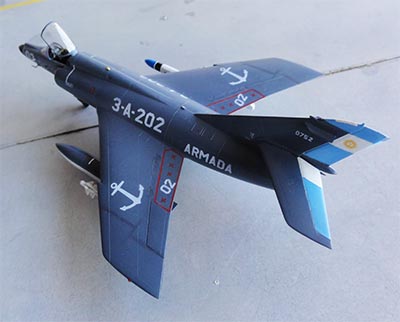
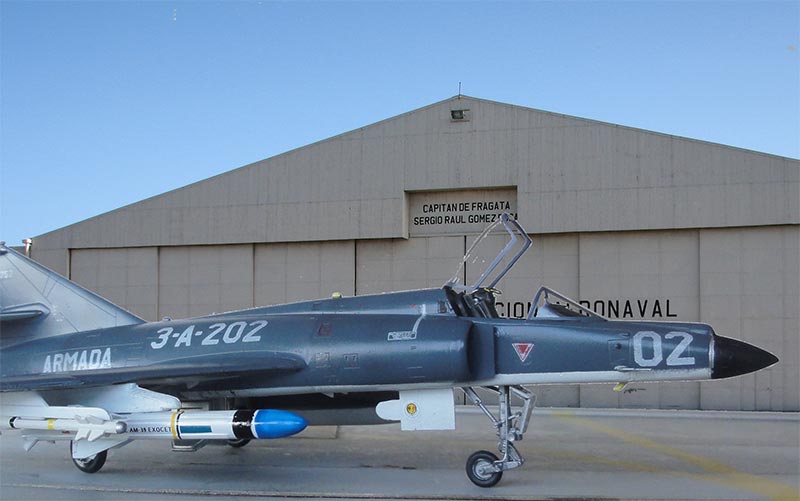

The same kit was made (but now the Italeri release) in an Iraqi air force scheme. Photos are rare of real Iraqi Super Etendard but a few black and white photos were found on the internet.
The assembly of the model was done as described earlier above.
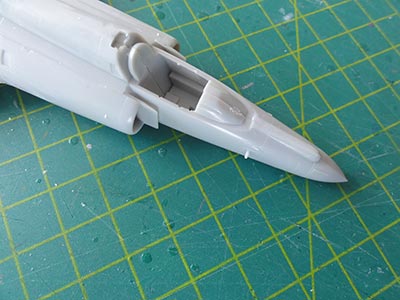
I opted to set the air brakes drooped down. The holes in kit parts were drilled open.
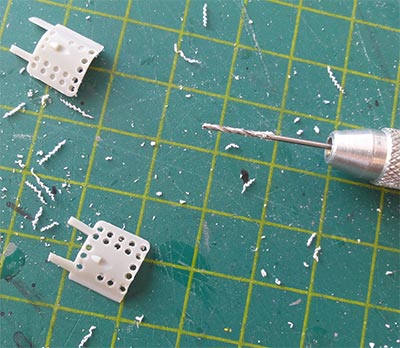
I used a mix of decals found in the spares decal box:
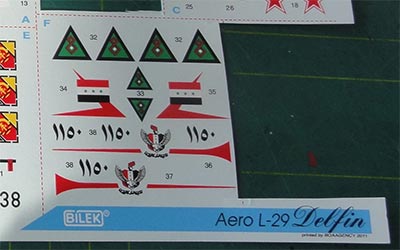
The Iraqi roundels and flags were used from a Bilek L-29 set. (they can also be found in a Propagteam set 72043). Note that the Iraqi flags on the vertical tail are not set horizontal in flight on real aircraft but tilted, so when parked on the tarmac, the flag is horizontal.
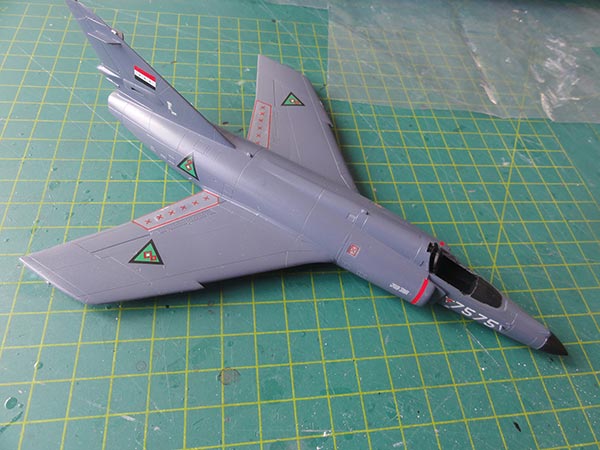
On the model red stripes were set on the intakes.
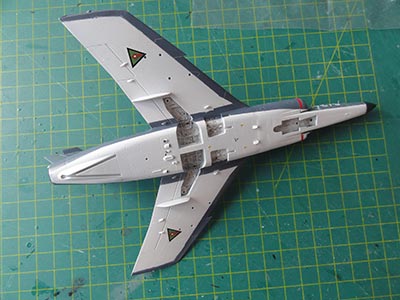
The completion with smaller parts and undercarriages and final finishing with a gloss coat were done as described with the first kit. Magic missiles from a Special Hobby Mirage F-1 kit were used, painted now light grey.
IRAQ
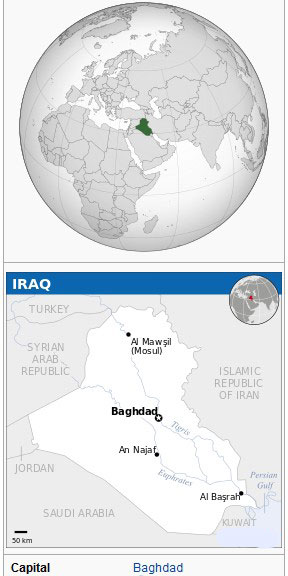


The Iraqi Air Force was established in 1931 and used British military equipment. Iraq was a monarchy. Aircraft bases were at Habbaniya and Shaibah and training aircraft were Chipmunks and later on the Harvard. In the 1950s Vampire jets were acquired. Later on also Soviet aircraft were ordered such as various Mikoyan MiGs including MiG-15 as well as French fighter aircraft. From Czechoslovakia L-29 Delfin were ordered as the standard trainer for MiG jet crews. Some 78 L-29 Delfins were delivered between 1968 to 1974. In the 1970s France was to deliver Mirage F-1 fighters and 5 Super Etendards were "loaned" in 1983. Many Soviet jets were still being acquired like MiG-23, MiG-25, MiG-29 and Sukhois and put into service (see SU-22 page..).
Sadam Hussein came to power mid 1979 and conflicts began with Iran and from 1984 strike missions with the Super Etendard with Exocet missiles began against Iranian shipping in the Gulf. France stated that in 1985 four of the five loaned aircraft were returned to France.
An invasion of Kuwait came August 1990. This resulted in the first Gulf War with the West supporting the smaller Arab countries in the region with Operation Desert Storm. It was "live" covered by CNN at television with absurd shots taken from hotel roofs. Iraq military retrieved and had large losses. A decade later the war against terrorism of 2003 eventually saw Hussain located, captured and executed by locals. A new elected government was installed but still the situation in the country and region is unstable with conflicts up till today. There is still an American presence.

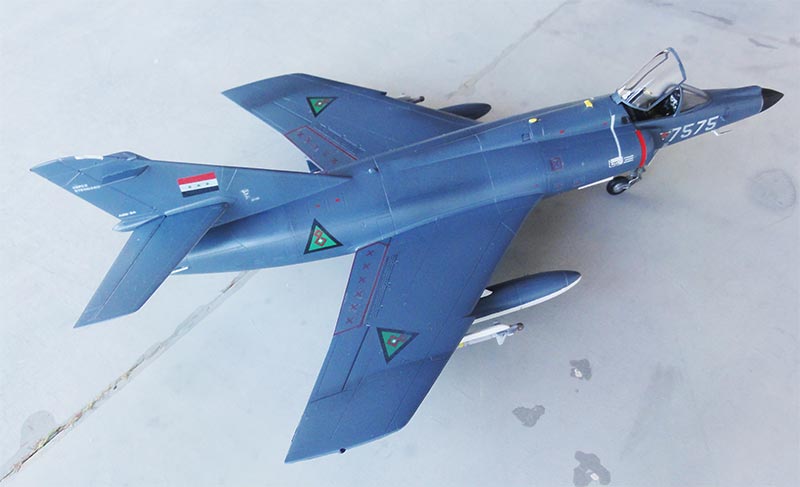
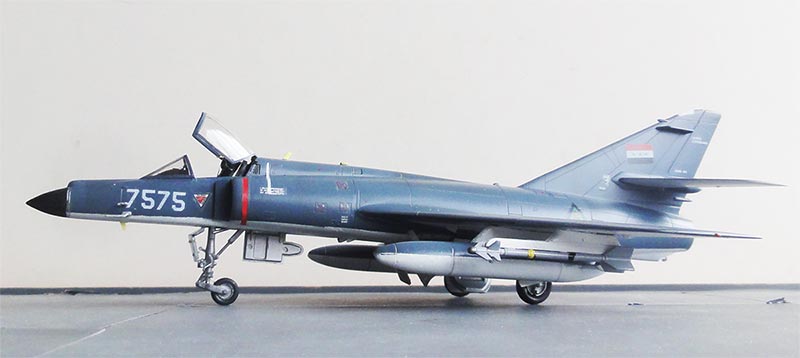
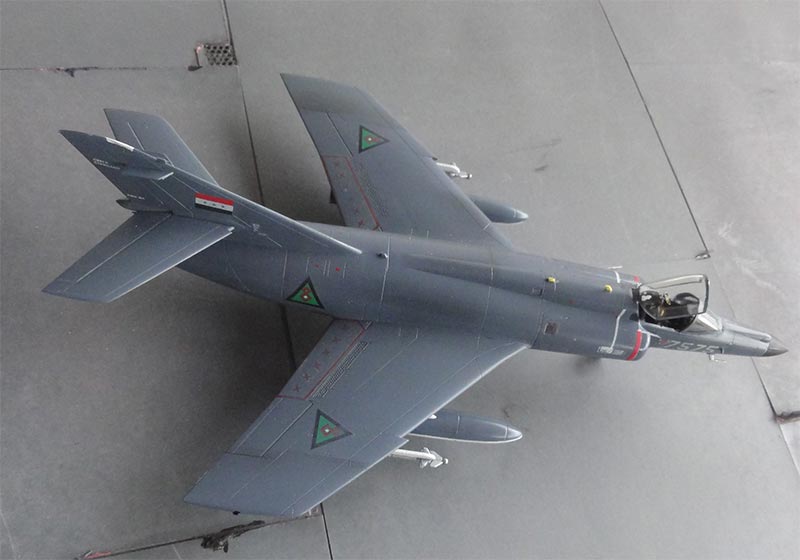
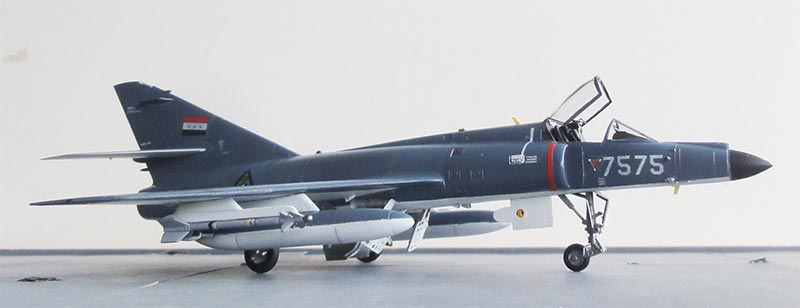
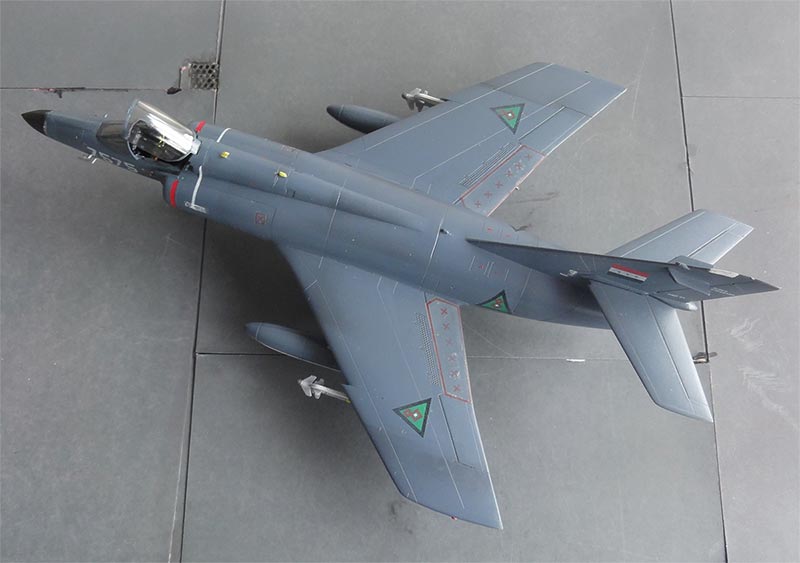
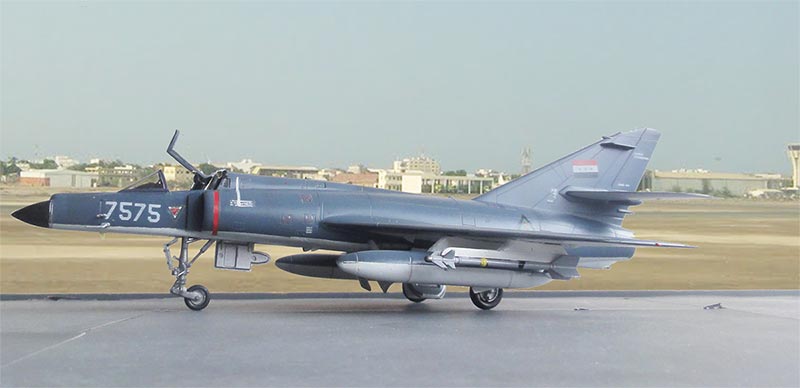
The total of about 14 hours were needed for the 2 models. Nice ones for the World Air Forces in Plastic collection.
On to next Super Etendard [ Page 3.... ]
Back to 1/72 Models.......

(c) Copyright "designer"/ All rights reserved. Your comments are welcomed by webmaster
Created this page
June 25, 2018